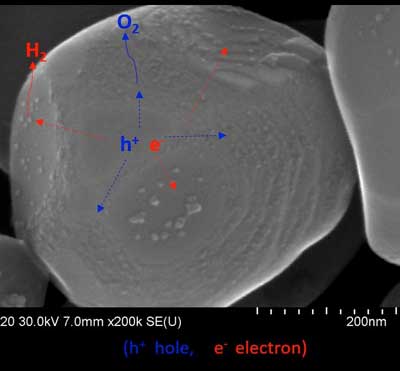| Jun 03, 2020 |
Solar hydrogen production: Splitting water with UV is now at almost 100% quantum efficiency
|
|
(Nanowerk News) Pour yourself a glass of water and take a look at it. This water contains an abundant source of fuel, hydrogen. Hydrogen burns clean unlike petrol-based energy products. Sound too good to be true?
|
|
Scientists in Japan successfully split water into hydrogen and oxygen using light and meticulously designed catalysts, and they did so at the maximum efficiency meaning there was almost no loss and undesired side reactions.
|
|
This latest breakthrough in solar hydrogen production makes the likelihood of scalable, economically viable hydrogen production more than likely, paving the way for humanity to make the switch to clean energy.
|
 |
| Aluminum-doped strontium titanate photocatalyst. (Image: Tsuyoshi Takata Ph.D., Center for Research Initiative for Supra-Materials, Shinshu University)
|
|
Water splitting using catalysts and sunlight, called photocatalysis has been a promising method of achieving solar hydrogen production for decades. However, most previous attempts only yielded an external quantum efficiency of less than about 50% representing the difficulty in efficient catalyst design for real world use.
|
|
The catalyst needed to be designed better so every absorbed photon from the light source is used to make hydrogen. The key to improving efficiency was strategic placement of the co-catalysts and preventing defects in the semiconductor.
|
|
Published in Nature ("Photocatalytic water splitting with a quantum efficiency of almost unity"), Tsuyoshi Takata of Shinshu University et al. broke through new frontiers in power production by using aluminum-doped strontium titanate as a photocatalyst, whose properties have been extensively studied and therefore the best understood.
|
|
They choose co-catalysts rhodium for hydrogen with chromium oxide, and cobalt-oxide for oxygen, by fine-tuning them to engage in only desired reactions. This method made possible for the reaction to have no recombination losses.
|
|
These new findings open the doors to achieve scalable and economically viable solar hydrogen production. Their design strategies succeeded in reducing defects that lead to near perfect efficiency, and knowledge obtained will be applied to other materials with intense visible light absorption.
|
|
More work is still needed before we can run our cars on hydrogen, because this study focused on the use of ultraviolet light and abundant visible light from the sun remained unused. However, this great breakthrough has made that possibility no longer too good to be true, but in theory, just a matter of time. Hopefully it will encourage scientists, researchers and engineers to engage in this field, bringing the use of solar hydrogen power that much closer.
|

